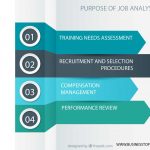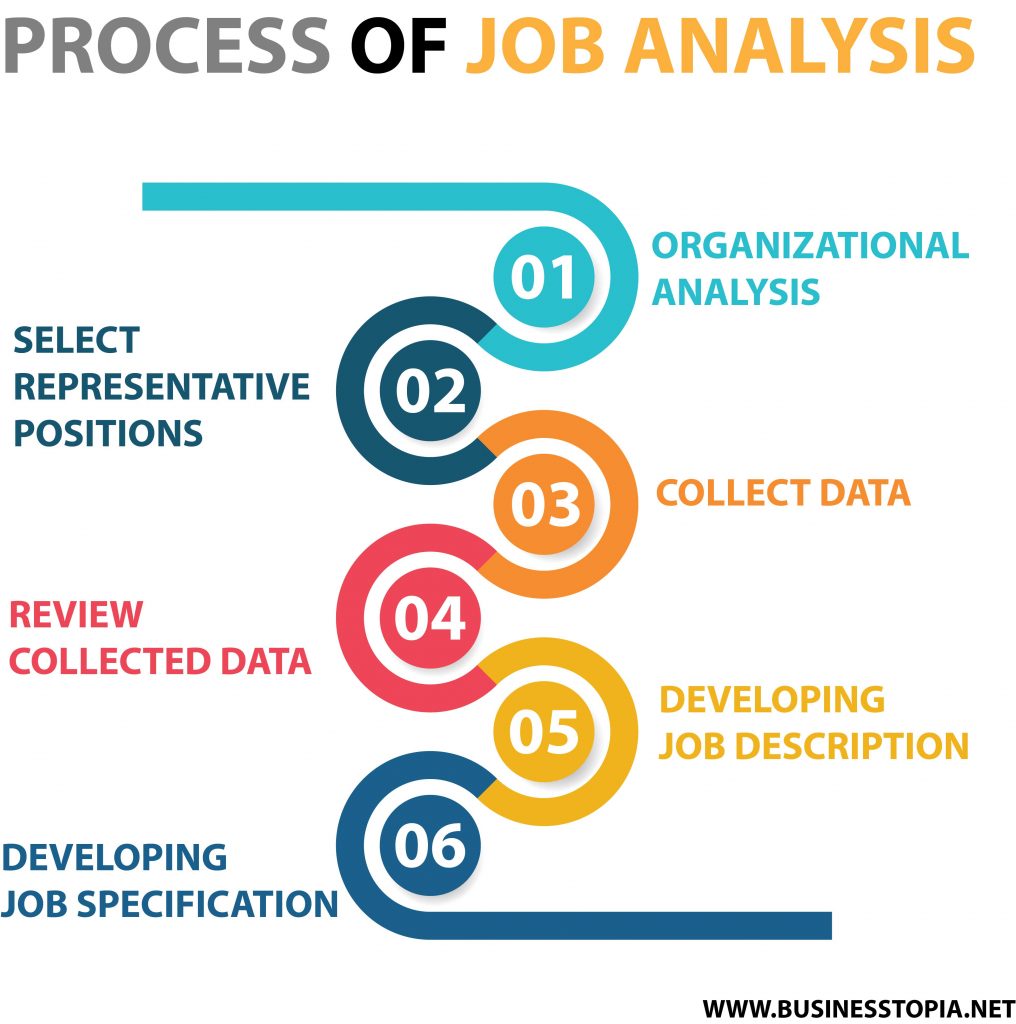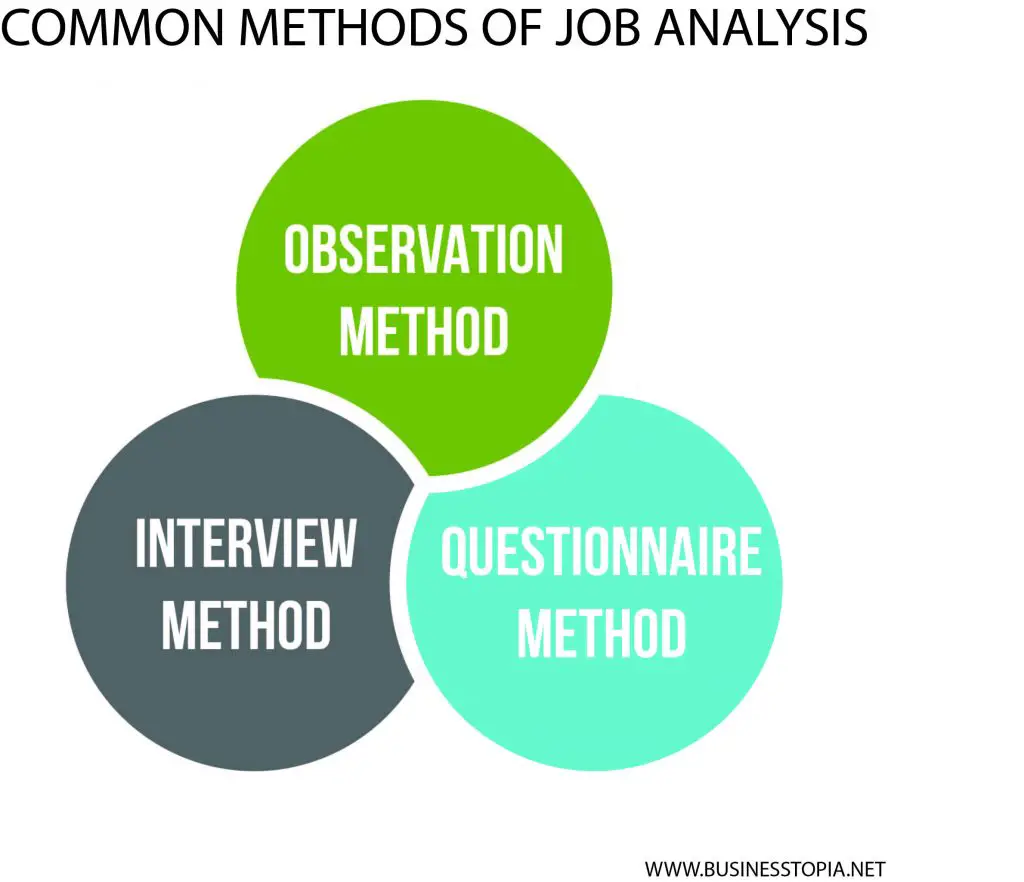Job analysis is a process of identifying and determining in detail the particular job duties and requirements and the importance of these duties for a given job. It helps an organization determine which employee is best for a specific job.
In other words, job analysis is used to determine placement of jobs. It allows human resource managers to identify the path of job progression for employers looking to advance their career and compensation.
To be clear, job analysis targets the job, not the person. Data for job analysis is collected from the job holders through interviews or questionnaires, but the result of analysis is a description of the job and not a description of the job holder.

History
Russian researcher Morris Viteles was one of the first industrial-organizational psychologists to introduce the concept of job analysis. In 1922, he used the method of job analysis to choose employees for a trolley car company.
Frederick Winslow Taylor and Lillian Moller Gilbreth also conceptualized job analysis in the early 20th century.
Definitions of job analysis
Some popular definitions of job analysis are as follows:
Harry L. Wylie:
“Job analysis deals with the anatomy of the job…..This is the complete study of the job embodying every known and determinable factor, including the duties and responsibilities involved in its performance; the conditions under which performance is carried on; the nature of the task; the qualifications required in the worker; and the conditions of employment such as pay, hours, opportunities and privileges.”
Michael J. Jucius:
“Job analysis refers to the process of studying the operations, duties and organisational aspects of jobs in order to derive specification or, as they are called by some job description”
Blum:
“A job analysis is an accurate study of the various components of a job. It is concerned not only with an analysis of the duties and conditions of work, but also with the individual qualifications of the worker.”
John A Shubin:
“Job analysis is the methodical compilation and study of work data in order to define and characterise each occupation in such a manner as to distinguish it from all others.”
Purpose of job analysis
Job analysis is used in preparation of job descriptions and job specifications which help in the hiring of right personnel for the job. The general purpose of job analysis is to establish and document the requirements of a job.
The aim of job analysis is to answer questions such as:
- What is the purpose of the job?
- What physical and mental task does the job holder undertake?
- When is the job to be performed?
- Where is the job to be performed?
- What are the conditions required for the job to be performed?

Training needs assessment
Job analysis is used to determine training needs such as training content, assessment tests, test equipment and methods of training. It is also useful in identifying the areas where an employee needs training.
Compensation management
Compensation management/salary administration is one of the core HR functions. Job analysis can be used in determining skill levels, compensable job factors, required level of education, etc. It is important in deciding pay packages and job benefits of employees. The pay depends on the position, job title, duties and responsibilities associated with a job. Job analysis guides HR managers in deciding how much an employee is worth.
Recruitment and selection procedures
Job analysis helps in hiring the right person for a job. It helps in identifying the job duties that should be included in vacancy announcements. It also helps in collecting information on educational qualifications, minimum requirements, and appropriate salary level.
Performance review
Every organisation has goals and objectives to achieve and certain performance standards to be maintained by its employees. Job analysis helps in identifying the goals and objectives, performance standards and evaluation criteria and duties to be evaluated.
Process of job analysis
Job analysis process involves the implementation of following steps:

Organizational analysis
The first step in the job analysis process is to determine its purpose. This will help determine what kind of data to collect and how to collect it. The necessary background information for this step can be collected by using organization charts, process charts and job descriptions.
Select representative positions
It will be time consuming and costly to analyse all jobs in an organization. So, it is essential to select a representative sample of jobs for detail job analysis.
Collect data
The next step is to collect job-related data such as educational qualification, duties, responsibilities, working conditions, employee behaviour, skills and abilities. Data is collected by using methods such as observation, interviews and questionnaire.
Review collected data
A job analysis report is prepared by using the gathered data. The information is then verified with the worker performing the job and their supervisor.
Developing job description
The information collected is used to develop a written statement known as job description. Job description is a document that describes the responsibilities, working conditions, locations, risks and tasks required for effective job performance.
Developing job specification
The final step in the process is to develop job specification. Job specification and job descriptions are two tangible products of the job analysis process. Job specification is a statement of personal traits, educational qualification, experience, background and skills needed to perform a job.
Approaches to job analysis
Job analysis is done by using two approaches:
Task oriented approach
Task oriented approach to job analysis focus on the actual activities involved in a job. It mainly considers duties and responsibilities of a job. HR managers develop task statements that state the functions of a job in great detail.
The tasks are then rated on the basis of importance, frequency, difficulty etc. This helps in having a greater understanding of the requirements of a job.
Worker oriented approach
Examining human attributes of a job is another approach of job analysis. These attributes are classified as knowledge, skills, abilities, and other characteristics, collectively known as KSAO.
Knowledge refers to the information required by an employee to perform the job. Skills are the proficiencies needed for good performance. Abilities refers to the attributes of employees that are stable over time. Other attributes such as personality factors are other characteristics.
Methods of job analysis
Different methods such as observation, interview, checklists, task inventories, and questionnaire can be used individually or in combination. Choosing the method or combination of methods of job analysis depends upon the needs and requirements of the organization.
Here are the three most common job analysis methods used by organizations:

Observation method
The job analyst observes and records the tasks, responsibilities and duties of an employee. This also includes the methods and skills used by them to perform the job. This is the most difficult method of job analysis.
This is because every person has their own way of observation and interpretation, which can involve personal biases. This error can be minimized by choosing a properly trained job analyst.
Interview method
The job analyst interviews employees to know about their working style, problems faced, skills and techniques used and insecurities about their careers.
This method helps the analyst to know what an employee thinks of his job and the responsibilities it entails. The success of this method depends upon the genuineness of data and feedback collected from employees.
Questionnaire method
In this method, the job analyst gives an employee a simple questionnaire to identify the duties, responsibilities, work environment and problems related to a job. This method can also be biased if the questions are not framed properly.
